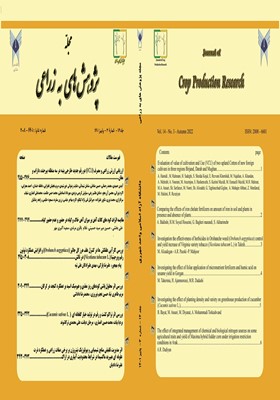بررسی اثر محلول پاشی کودهای ریز مغذی و هیومیک اسید بر عملکرد کنجد در گرگان
محورهای موضوعی : پژوهش های به زراعیمریم طاهری نژاد 1 , حسین عجم نوروزی 2 , محمدرضا داداشی 3
1 - کارشناسی ارشد
2 - دانشیار
3 - دانشیار
کلید واژه: دانه های روغنی, اسیدهای چرب, هیومیک اسید, کودهای ریزمغذی,
چکیده مقاله :
به منظور اثر محلول پاشی کودهای ریزمغذی و مصرف هیومیک اسید بر عملکرد و اجزای عملکرد کنجد در تاریخ کشت تأخیری، آزمایشی در مزرعه تحقیقاتی ایستگاه عراقی محله در سال زراعی 1401 انجام شد. این تحقیق به صورت طرح بلوک های کاملا تصادفی با 9 تیمار در 3 تکرار در مزرعه تحقیقاتی ایستگاه عراقی محله انجام شد. صفات مورد بررسی شامل ارتفاع بوته، شاخص برداشت، عملکرد دانه، وزن هزار دانه و عملکرد بیولوژیک بود. نتایج بدست آمده از این پژوهش نشان داد که تیمار بذرمال هیومیک اسید+ریزمغذی، شاهد و شاهد+کود آبیاری + بذرمال هیومیک اسید بیشترین عملکرد بیولوژیک را داشتند و پایین ترین عملکرد بیولوژیک مربوط به کود آبیاری هیومیک اسید و کود آبیاری+ریزمغذی بود. همچنین وزن هزار دانه در گروه شاهد و تیمار هشتم در مقایسه با دیگر تیمارها بطور معنی داری پایین تر بود. این نتایج نشان می دهد که استفاده از کودهای ریزمغذی و هیومیک اسید توانست بطور معنی داری وزن هزار دانه افزایش دهد. در نهایت عملکرد دانه بطور معنی داری در تیمار شاهد، شاهد+بذرمال هیومیک اسید و شاهد+بذرمال هیومیک اسید+ریزمغذی بطور معنی داری بیشتر از دیگر تیمارها بود. این نتایج نشان می دهد که بذرمال کردن هیومیک اسید نسبت به دیگر تیمارها اثرات بهتری بر عملکرد دانه داشته است.
In order to determine the effect of foliar application of micronutrient fertilizers and humic acid consumption on the yield and yield components of sesame in the delayed planting date, an experiment was conducted in the research farm of Iraqi Mahalle station in the crop year of 2022. This research was carried out as a completely randomized block design with 9 treatments in 3 replications in the research farm of the Iraqi Mahalle. In each plot, 5 rows were planted, the distance between rows was 40 cm and the distance between replications was 3 meters. The studied traits included plant height, harvest index, seed yield, thousand seed weight and biological yield. The results obtained from this study showed that the treatment with humic acid + micronutrient, control and control + irrigation fertilizer + humic acid fertilizer had the highest biological performance, and the lowest biological performance was related to humic acid irrigation fertilizer and irrigation fertilizer + micronutrient. Also, the weight of one thousand seeds in the control group and the eighth treatment was significantly lower compared to other treatments. These results show that the use of micronutrient fertilizers and humic acid could significantly increase the weight of a thousand seeds. Finally, the seed yield was significantly higher in control, control + humic acid seed, and control + humic acid seed + micronutrient than other treatments. These results show that application of humic acid has better effects on grain yield than other treatments.
_||_


